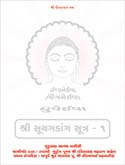
| Anga Aagam >> GNATA DHARMA KATHA SOOTRA | |||||
|
|||||
SHREE GNATA DHARMA KATHA SOOTRA
The first section contains a few famous short stories and the second section has incidents from 10 biographies.
Chapter 1: The description of the three previous births of King Shrenik’s son, Meghkumar is given in this chapter. In the previous birth as an elephant, he had suffered pain to protect a rabbit. Due to this feeling of compassion and mercy, he acquired a human life in the next birth. In the life of Meghkumar, he accepted restrain and became an ascetic, but his faith became a little weak and shaky. However, on hearing Lord Mahavir’s sermons he remembered who he was and his previous births and once again became stable in restrain and performed sadhana. In the next birth, he was born as a god, then as a human and finally attained liberation.
Chapter 2: The story of the merchant leader Dhanya and Vijay, the robber , teaches the saints how to eat for the survival of the body without attachment to food.
Chapter 3: ‘Faith is the master key to success.’ This is explained by the story of two friends who nurtured two eggs of a peacock (effects of Positive and negative thinking).
Chapter 4: The example of a tortoise is an inspiration to the devotees for control of the senses.
Chapter 5: The conduct of Shailak Rajarshi (a disciple of Shukla ascetic who was a disciple of Thavchchaputra) and his disciple Panthak illustrates the relationship between a guru and his disciple and also explains the fruit of the negligent and vigilant behaviour of saints.
Chapter 6: The example of sour gourd (Tumbdi) explains how jivas with tightly bonded karmas sink in the world whereas jivas with lightly bonded karmas sail the worldly ocean.
Chapter 7: The merchant leader Dhanya gave his 4 daughter-in-laws five grains of rice each, to test them. Through this, the devotees have been inspired to increase the feelings in the five great vows-mahavratas.
Chapter 8: A detailed description of the 19th Tirthankar Lord Mallinath’s previous birth along with his 3 other births are given.
Chapter 9: This chapter tells the story of the two brothers Jinpal and Jinrikshit which teaches us that the desire of sensual pleasure becames the cause of sorrows and its sacrifice gives freedom from sorrows.
Chapter 10: The rising and declining size of the moon gives guidelines for patterns of work and thus progress.
Chapter 11: The example of Davdruksh tree which grows on the seaside is a lesson for the devotees to become a worshipper by cultivating the qualities of tolerance and equanimity.
Chapter 13: The saying “Where there is liking there is creation” is explained by the life incidences of Nandmaniyar Shreshthi (leader of merchants).
Chapter 14: Incidences of Tetliputra and Pottila are an inspiration to break away from the worldly attachments.
Chapter 15: The example of Nandifal illustrates the fruits of desire for sensual pleasures and detachment from it.
Chapter 16: A detailed description of Draupadi’s character and her previous three births has been given.
Chapter 17: With the example of the behaviour of the (Jativaan) high breed horses, devotees are advised to take refuge in the duties of a saint, to obtain independence and peace.
Chapter 18: An incident from the life of the respected merchant’s daughter Susama advises the devotees to eat for the survival of the body but without having any liking for food.
Chapter 19: The story of two brothers Pundarik and Kundarik tells us to sacrifice the desire for sensual pleasures to be able to progress ahead while living a life of restrain as an ascetic.
Section 2: The 10 chapters of this section describe the previous births of the 206 Indrani’s (wives of Lord Indra).
The main principles of Jain religion have thus been highlighted in a simple manner through different stories.
| |||||


